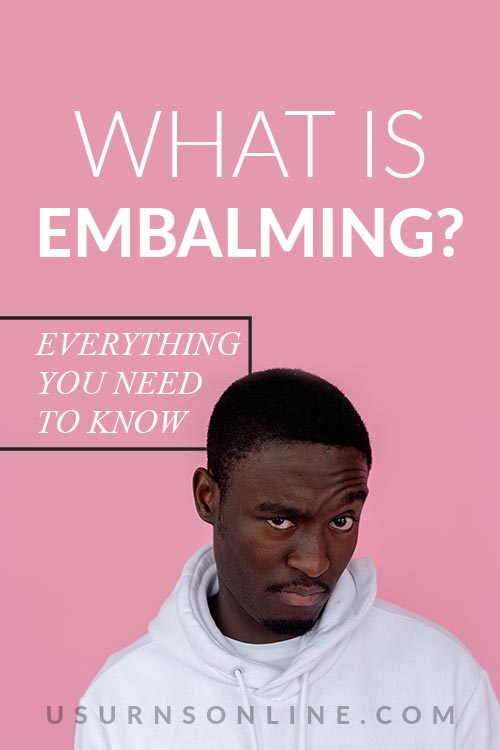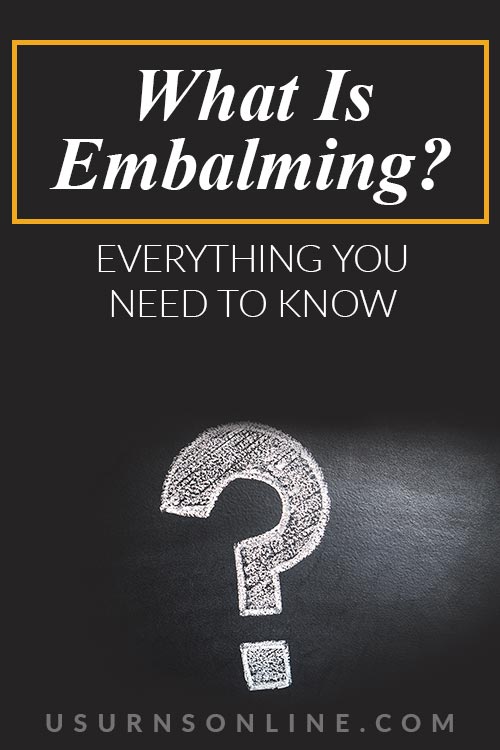If you’re faced with planning a funeral, at some point the embalming question is going to come up. What, exactly, is involved in the embalming process, and how can you decide if it’s the right choice?
We’re going to talk about everything you need to know about embalming: the purpose and method of the procedure, the chemicals used, the reason it’s done, the cost, and the pros and cons.
Let’s jump in.
What Is Embalming?
Embalming is the art and science of preserving human remains by treating them to slow down decomposition.
This procedure is usually done to make the body suitable for public or private viewing, especially when the viewing is a part of the funeral ceremony. Additionally, embalming is often used to keep the body preserved for medical purposes in an anatomical laboratory or school.
Types of Embalming
There are two types of embalming: Arterial embalming and cavity embalming. Both types are done in the typical embalming process.
When performing arterial embalming, the blood is removed from the body through the veins and replaced with the embalming solution through the arteries. The blood is literally flushed from the body as the embalming fluid is pushed through the circulatory system.
When performing cavity embalming, the internal fluids are removed from body cavities by way of an aspirator and trocar.
Why Are Bodies Embalmed?
Embalming does three things:
- Disinfects the body
- Slows down the natural decomposition process
- Improves the appearance of the loved one
Together, these features allow a funeral to be delayed for several days, providing the family with more time to mourn and prepare for the service and the burial (or cremation).
Urns Made in the USA
Embalming Laws & Regulations
Another reason that an embalming might be performed is due to state law, or funeral home requirements/regulations.
There are no state laws that require routine embalming for every death. Some states require embalming or refrigeration if the body is not buried or cremated within a specific time.
Most states have no requirements, but rather leave it to the discretion of the funeral home. Each funeral home will have their own policies but the best practices are all pretty much the same:
The body should be buried or cremated within a few days, and if the funeral is scheduled later than that, the funeral director will recommend embalming (refrigeration may also be an option). They will also recommend embalming for most open-casket funerals or viewings.
Reasons to Embalm
Here are some of the reasons families will frequently choose to have their loved one embalmed.
- You have planned a public viewing.
- Embalming disinfects and slows down decomposition.
- The deceased requested embalming in a pre-need arrangement.
- Some funeral homes don’t have refrigeration. It is unsanitary to leave the deceased at room temperature for long periods of time.
- Embalming fluids enhance the color of the deceased’s face and hands with chemical pigmentation.
- You want to see your loved one “at rest.”
- Helps to provide closure to family members and friends.
Reasons Not to Embalm
- There is no viewing planned.
- You have requested a direct cremation.
- The deceased is having a direct burial.
- The funeral director placed the body in refrigeration.
- The state law doesn’t require embalming.
- You object to the use of formaldehyde, glutaraldehyde, and other chemicals
- Some religions don’t allow embalming.
- Embalming is not environmentally friendly.
- The EPA lists embalming fluid as a possible carcinogen.
- Embalming is expensive.
Related: Here’s What Happens to the Body After Death
The Embalming Process
Now that we’ve defined embalming, answered some common questions, and addressed the pros and cons, let’s look at the actual embalming process.
Step 1: Wash and disinfect the body.
The embalmer washes and disinfects the body and mouth before embalming begins. He will also massage the arms and legs to relieve rigor mortis of the joints and muscles. Any shaving would also take place at this time.
Step 2: Place the body on the embalming table and set features.
After the body is bathed, the features are set: the mortician closes the eyes and properly positions mouth.
The eyes are closed using plastic eye caps, which sit on the eye and hold the eyelid in place. The mouth is either wired shut or sewn shut.
Step 3: Inject the embalming fluids.
The embalmer will make an incision in the right common carotid artery and the right jugular vein. Then he will pump around two gallons of a formaldehyde-based solution into and through the body from the carotid artery.
As the embalming solution is injected, this will force out blood currently in the veins. The drainage of blood will be through the jugular.
Step 4: Cavity embalming takes place.
Gas and body fluids are removed from the stomach, bladder, intestines, and lungs using a suction hose attached to a trocar.
A trocar is a surgical instrument with a three-sided cutting point enclosed in a tube used to withdraw fluid from a body cavity.
The embalmer will remove the body fluids. Then, these areas are injected with cavity fluid. Cavity fluid is stronger than embalming fluid, and is used to preserve while also maintaining the shape and form of each cavity.
Step 5: The incisions are sewn up.
The embalmer will sew up the incision in the neck after the body and the body cavity is embalmed; then, he will close the hole in the abdomen with a trocar button.
Step 6: Give the body a final bath, then dress and apply final care touches.
Give the body one last bath and pat dry. Comb the hair.
The next day, seal the incisions with bonding adhesive to prevent any leakage. Dress the body, apply cosmetics and fix the hair.
Questions About Embalming
Does a body have to be embalmed?
Though it is still a common procedure, embalming is rarely necessary. However, funeral homes usually insist upon embalming for public viewing.
Can you have an open-casket funeral or viewing without embalming?
You are not required to have your loved one embalmed for most funerals. This is subject to state law. Therefore, having an open casket without embalming is possible. But most funeral homes will not allow a public viewing without embalming.
Are organs removed during embalming?
No. The mortician leaves the organs in the body cavity; the organs are embalmed during the cavity embalming process.
Is blood drained during embalming?
Yes. The embalmer replaces the blood with embalming fluid.
What does the mortician do with the drained blood?
The mortician flushes the blood and other waste down the drain. The blood then enters the sewage system. The wastewater treatment system will handle it from there.
How long does embalming last?
It is important to understand that the process of embalming does not stop decomposition; it just slows it down.
An embalmed body placed in a casket can last for many years. The rate of decomposition will vary. It depends on the strength of the embalming chemicals used.
But practically speaking, embalming is about making the decedent look as best as possible. To this end, an embalmer will be able to preserve the body for roughly a week, perhaps ten days. Nevertheless, even with embalming, decomposition will begin after about a week.
So, if you plan on having an open-casket funeral, then you should not leave the embalmed body out for more than a week.
How long does embalming take?
The embalming process usually takes about two hours. If the body has been in an accident, or was subject to an autopsy, the embalming process will be more involved and take longer.
How much does embalming cost?
The cost of embalming can vary from one location to another. However, the average cost is around $500-$700.
Why does the funeral home recommend embalming?
The funeral industry suggests embalming and viewing as a way to show “proper respect for the body.” In addition, viewing helps the family and friends of the deceased to have closure.
Historically, embalming is a relatively new procedure and one that is exclusive to the funeral professionals. It is a service that they sell, so remember: if you do not want embalming, you can simply say no. There are alternatives:
- Eco-embalming
- Refrigeration and/or ice
- Direct cremation
- Direct burial
What happens if a body is not embalmed?
The body will decompose faster without embalming. The decomposition rate will depend on the cause of death, the weight of the deceased, and environmental factors.
Practically speaking, if the body is not embalmed, you will need to hold a service and bury or cremate very soon after death.
Read more: What Happens to a Body After Death?
How long can a body be kept without embalming?
You can refrigerate a body for an indefinite period of time.
Can you cremate an embalmed body?
Yes, you can cremate an embalmed body. Embalming does not affect the cremation process.
Related: 25 Weird Questions About Cremation That People Always Ask
Do embalmed bodies look different?
Embalmed bodies will look different than a living person. Embalmers do their best to make the body look as natural as possible. Because every individual is unique, because the embalmer is limited to a couple of photos to work from, and because there is truly an art to the process, some results may be better or worse than others.
There are also times after embalming that a person looks better than when they died. For example, if someone has suffered a long illness, embalming can fill them out and give them color.
What does formaldehyde do to the body?
Formaldehyde is a strong chemical preservative that changes body tissue at a molecular level. This ensures that bacteria cannot thrive by feeding on the tissue.
As for the living, when exposing an embalmer to formaldehyde, there are a few things that can happen.
- Cancer
- Burning eyes, nose, and throat
- Watery eyes
- Coughing
- Wheezing
- Nausea
- Skin irritation
Embalming chemicals are not taken lightly, so morticians will take the proper precautions to ensure their safety as well as the safety of funeral home visitors and staff.
Is embalming bad for the environment?
Embalming fluid can be extremely harmful to the environment. It affects the soil and water. For example, when burying an embalmed body, the formaldehyde in the embalming fluid can seep into the ground.
In addition, the chemical can bond with moisture in the atmosphere and find its way into rain and snow. We (here in the US) use more than five million gallons of embalming fluid each year. That sounds a bit excessive.
Read more: Embalming Alternatives That Avoid Formaldehyde
What are the burial options for an embalmed body?
You can bury or cremate an embalmed body after the funeral. Embalming rules out a “natural burial” because of the chemicals that would be leaked into the ground. A natural burial is also called an “eco-friendly” or “green” burial.
Learn more about each of these options:
- Burial: Your Guide to Traditional (& Non-Traditional) Burials
- The Cremation Process, and How to Arrange a Cremation
- Natural Burial: How to Celebrate Life with a Green Funeral
Now that you’ve read our article on embalming, you can impress your friends with all of your knowledge. Have fun!





